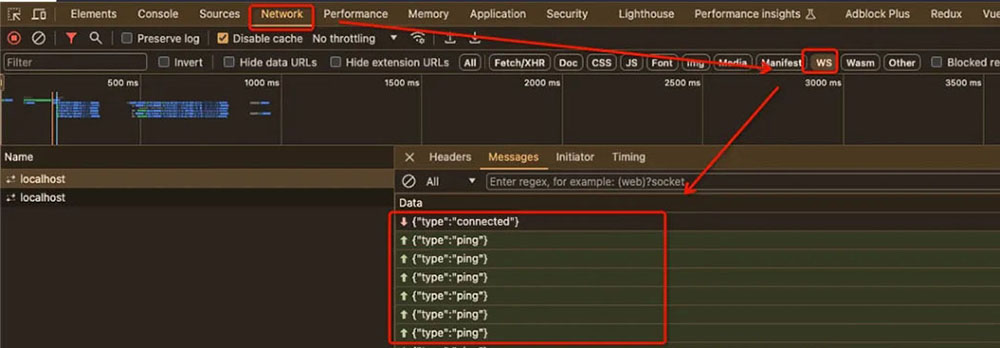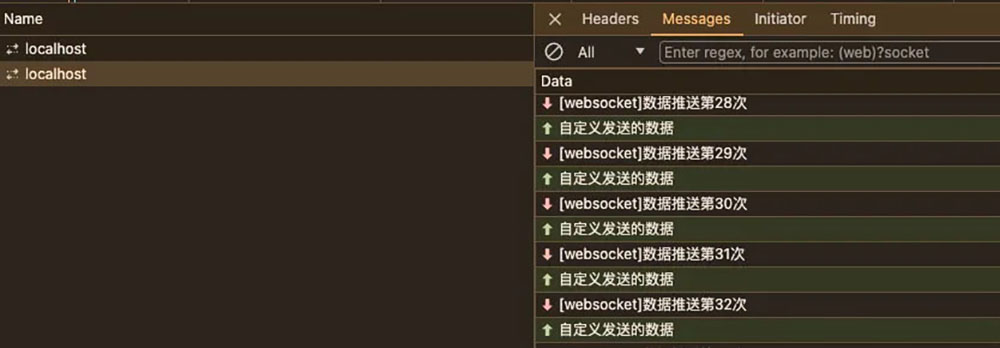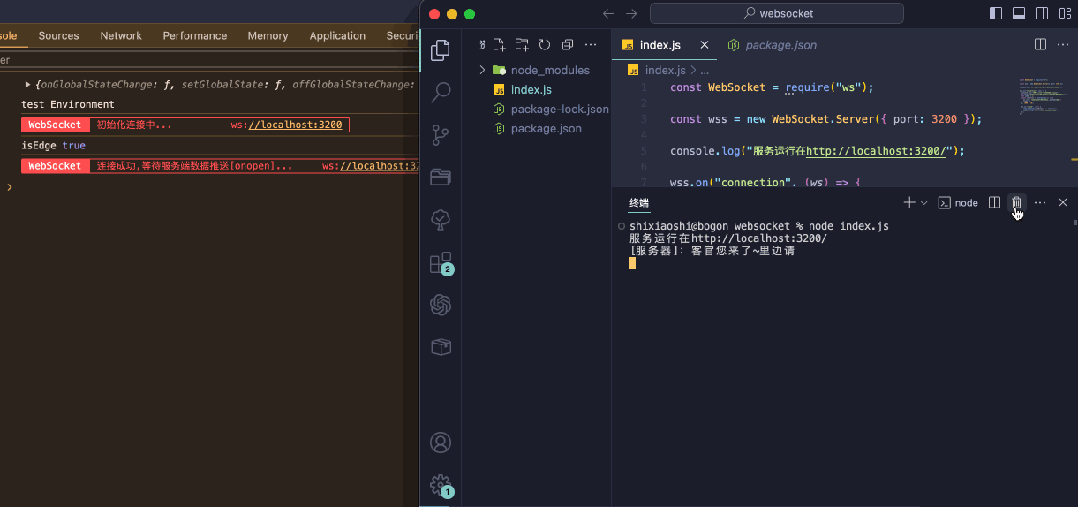不容错过!顶级WebSocket封装库:支持断网自动重连与智能心跳检测!
在前端开发中,WebSocket技术无疑是不可或缺的核心技能之一。尽管在某些项目中可能并不直接使用,但掌握WebSocket对于深入理解实时通信和构建高效、稳定的实时应用至关重要。
最近,我就遇到了一个明确的需求,要求界面数据通过WebSocket实现实时推送,并且该功能需要支持断网重连和自动心跳机制。断网重连功能确保在网络中断后能够自动恢复与服务器的连接,保持数据的持续传输。而自动心跳则通过定期向服务端发送小型数据包来检测连接状态,若服务端在一段时间内未收到心跳响应,系统将自动采取断开连接等相应措施,以确保资源的有效管理和连接的稳定性。
这两项功能的结合,不仅增强了系统的健壮性,也为用户提供了更加流畅、可靠的实时交互体验。因此,掌握WebSocket及其高级特性,对于前端开发人员来说,无疑是一项宝贵的技能。
websokect的API非常简单
// 创建ws连接
const ws = new WebSocket('ws://localhost:8080/test');
ws.onopen = function() {
console.log('WebSocket 连接已经建立。');
ws.send('Hello, server!');
};
ws.onmessage = function(event) {
console.log('收到服务器消息:', event.data);
};
ws.onerror = function(event) {
console.error('WebSocket 连接出现错误:', event);
};
ws.onclose = function() {
console.log('WebSocket 连接已经关闭。');
}但是,要封装一个支持断网重连、自动心跳的websokect没有那么容易!
封装成功演示
核心优势
我们先看我封装的websokect,首先,最重要的,它的使用方法和官方Api完全一致!零学习成本,上手即用!
import WebSocketClient from "./WebSocketClient"
// 创建实例
const ws = new WebSocketClient('ws://localhost:3200');
// 连接
ws.connect()
// 同原生方法
ws.onclose(()=>{})
// 同原生方法
ws.onerror(()=>{})
// 同原生方法
ws.onmessage(()=>{
// 同原生方法
ws.send("自定义发送的数据")
})
// 同原生方法
ws.onopen(()=>{})
// 关闭连接
ws.close()后端服务创建
我们先使用node创建一个后端服务,安装ws库:
npm install ws
创建node index.js文件,引入WebSocket 服务器
const WebSocket = require("ws");
const wss = new WebSocket.Server({ port: 3200 });
console.log("服务运行在http://localhost:3200/");
wss.on("connection", (ws) => {
console.log("[服务器]:客官您来了~里边请");
ws.send(`[websocket云端]您已经连接云端!数据推送中!`);
let index = 1;
const interval = setInterval(() => {
ws.send(`[websocket]数据推送第${index}次`);
index ++
}, 1000 * 10);
ws.on("close", () => {
clearInterval(interval); // 清除定时器
console.log("[服务器]:客官下次再来呢~");
});
});我们启动这个服务
node index.js
现在,我们在前端服务内进行连接测试
前端websokect测试
我们先写前端的相关逻辑
import { WebSocketClient } from '@/utils/dataDispatcher/WebSocketClient';
const ws = new WebSocketClient('ws://localhost:3200');
// 连接
ws.connect();
// 同原生方法
ws.onclose(() => {});
// 同原生方法
ws.onerror(() => {});
// 同原生方法
ws.onmessage(() => {
// 同原生方法
ws.send('自定义发送的数据');
});
// 同原生方法
ws.onopen(() => {});启动项目,我们会发现控制台已经有了提示

等待一段时间后,我们可以看到ws连接里,前端已经发送了多次心跳数据

服务端与客户端也一直在进行数据交互

断网重连验证:
可以看到,当我们断开服务端的时候,断网重连被自动触发。

技术路线
基本框架搭建
export class WebSocketClient {
// #socket链接
private url = '';
// #socket实例
private socket: WebSocket | null = null;
constructor(url: string) {
super();
this.url = url;
}
// >消息发送
public send(message: string): void {
if (this.socket && this.socket.readyState === WebSocket.OPEN) {
this.socket.send(message);
} else {
console.error('[WebSocket] 未连接');
}
}
// !初始化连接
public connect(): void {
if (this.socket && this.socket.readyState === WebSocket.OPEN) {
return;
}
this.socket = new WebSocket(this.url);
// !websocket连接成功
this.socket.onopen = event => {
console.log(`连接成功,等待服务端数据推送[onopen]...`);
};
this.socket.onmessage = event => {
};
this.socket.onclose = event => {
console.log(`连接断开[onclose]...`);
};
this.socket.onerror = event => {
console.log(`连接异常[onerror]...`);
};
}
// >关闭连接
public close(): void {
if (this.socket) {
this.socket.close();
this.socket = null;
}
}
}上述代码借助官方API实现了一个基本的 WebSocket 客户端,具有以下功能:
● 初始化连接并处理各种 WebSocket 事件(打开、消息、关闭、错误)。
● 发送消息到服务器。
● 关闭连接。
现在,我们开始逐步完善代码,进行封装。
断网重连封装
export class WebSocketClient{
// #socket链接
private url = '';
// #socket实例
private socket: WebSocket | null = null;
// #重连次数
private reconnectAttempts = 0;
// #最大重连数
private maxReconnectAttempts = 5;
// #重连间隔
private reconnectInterval = 10000; // 10 seconds
constructor(url: string) {
super();
this.url = url;
}
// >消息发送
public send(message: string): void {
if (this.socket && this.socket.readyState === WebSocket.OPEN) {
this.socket.send(message);
} else {
console.error('[WebSocket] 未连接');
}
}
// !初始化连接
public connect(): void {
if (this.reconnectAttempts === 0) {
console.log(`初始化连接中...`);
}
if (this.socket && this.socket.readyState === WebSocket.OPEN) {
return;
}
this.socket = new WebSocket(this.url);
// !websocket连接成功
this.socket.onopen = event => {
// 重置重连尝试成功连接
this.reconnectAttempts = 0;
console.log(`连接成功,等待服务端数据推送[onopen]...`);
};
this.socket.onmessage = event => {
};
this.socket.onclose = event => {
if (this.reconnectAttempts === 0) {
console.log(`连接断开[onclose]...`);
}
if (!this.stopWs) {
this.handleReconnect();
}
};
this.socket.onerror = event => {
if (this.reconnectAttempts === 0) {
console.log(`连接异常[onerror]...`);
}
};
}
// > 断网重连逻辑
private handleReconnect(): void {
if (this.reconnectAttempts < this.maxReconnectAttempts) {
this.reconnectAttempts++;
console.log(`尝试重连... (${this.reconnectAttempts}/${this.maxReconnectAttempts})`);
setTimeout(() => {
this.connect();
}, this.reconnectInterval);
} else {
console.log(`最大重连失败,终止重连: ${this.url}`);
}
}
// >关闭连接
public close(): void {
if (this.socket) {
this.socket.close();
this.socket = null;
}
}
}上述代码添加了自动断网重连的机制。其核心逻辑在于以下几个方面:
1.「记录重连次数」:通过 reconnectAttempts 属性记录当前已经尝试重连的次数。
2.「设置最大重连次数」:通过 maxReconnectAttempts 属性设置允许的最大重连次数。
3.「重连逻辑」:在 onclose 和 onerror 事件中调用重连处理函数 handleReconnect。
4.「重连间隔」:通过 reconnectInterval 属性设置每次重连的间隔时间,可以在每次重连时增加间隔以实现指数退避。
5.「初始化连接并处理事件」
在 connect 方法中,初始化 WebSocket 连接并为其设置事件处理函数。特别关注 onclose 和 onerror 事件,在连接关闭和出现错误时调用重连逻辑。
public connect(): void {
if (this.reconnectAttempts === 0) {
console.log(`初始化连接中...`);
}
if (this.socket && this.socket.readyState === WebSocket.OPEN) {
return;
}
this.socket = new WebSocket(this.url);
this.socket.onopen = (event: Event) => {
this.reconnectAttempts = 0;
console.log(`连接成功,等待服务端数据推送[onopen]...`);
};
this.socket.onclose = (event: CloseEvent) => {
if (this.reconnectAttempts === 0) {
console.log(`连接断开[onclose]...`);
}
this.handleReconnect();
};
this.socket.onerror = (event: Event) => {
if (this.reconnectAttempts === 0) {
console.log(`连接异常[onerror]...`);
}
this.handleReconnect();
};
}处理重连逻辑
在 handleReconnect 方法中,实现了实际的重连逻辑。该方法会递增 reconnectAttempts,检查是否达到最大重连次数,如果没有达到,则在指定的重连间隔后再次调用 connect 方法尝试重连。
private handleReconnect(): void {
if (this.reconnectAttempts < this.maxReconnectAttempts) {
this.reconnectAttempts++;
console.log(`尝试重连... (${this.reconnectAttempts}/${this.maxReconnectAttempts})`);
setTimeout(() => {
this.connect();
}, this.reconnectInterval * this.reconnectAttempts); // 重连间隔可以增加,例如指数退避
} else {
console.log(`最大重连失败,终止重连: ${this.url}`);
}
}关闭连接
在 close 方法中,手动关闭 WebSocket 连接并将 socket 设置为 null。
public close(): void {
if (this.socket) {
this.socket.close();
this.socket = null;
}
}自动心跳封装
自动心跳(Automatic Heartbeat)是一种在网络通信中常用的机制,用于维持连接的活跃状态,检测连接是否仍然有效,并及时发现和处理连接断开或故障的情况。心跳机制通过定期发送“心跳”消息(通常是一个简单的 ping 或者 pong 消息)来确认连接双方的状态。
实现自动心跳的基本思路
1. 发送心跳消息:在 WebSocket 连接建立后,启动一个定时器,定期发送心跳消息到服务器。
2. 接收心跳响应:服务器收到心跳消息后返回响应,客户端接收到响应后重置定时器。
3. 检测心跳超时:如果在指定时间内没有收到心跳响应,则认为连接断开,进行重连。
export class WebSocketClient {
// #socket链接
private url = '';
// #socket实例
private socket: WebSocket | null = null;
// #重连次数
private reconnectAttempts = 0;
// #最大重连数
private maxReconnectAttempts = 5;
// #重连间隔
private reconnectInterval = 10000; // 10 seconds
// #发送心跳数据间隔
private heartbeatInterval = 1000 * 30;
// #计时器id
private heartbeatTimer?: NodeJS.Timeout;
// #彻底终止ws
private stopWs = false;
// *构造函数
constructor(url: string) {
super();
this.url = url;
}
// >消息发送
public send(message: string): void {
if (this.socket && this.socket.readyState === WebSocket.OPEN) {
this.socket.send(message);
} else {
console.error('[WebSocket] 未连接');
}
}
// !初始化连接
public connect(): void {
if (this.reconnectAttempts === 0) {
console.log('WebSocket', `初始化连接中...`);
}
if (this.socket && this.socket.readyState === WebSocket.OPEN) {
return;
}
this.socket = new WebSocket(this.url);
// !websocket连接成功
this.socket.onopen = event => {
this.stopWs = false;
// 重置重连尝试成功连接
this.reconnectAttempts = 0;
// 在连接成功时停止当前的心跳检测并重新启动
this.startHeartbeat();
console.log(`连接成功,等待服务端数据推送[onopen]...`);
};
this.socket.onmessage = event => {
this.dispatchEvent('message', event);
this.startHeartbeat();
};
this.socket.onclose = event => {
if (this.reconnectAttempts === 0) {
console.log(`连接断开[onclose]...`);
}
if (!this.stopWs) {
this.handleReconnect();
}
};
this.socket.onerror = event => {
if (this.reconnectAttempts === 0) {
console.log(`连接异常[onerror]...`);
}
this.closeHeartbeat();
};
}
// > 断网重连逻辑
private handleReconnect(): void {
if (this.reconnectAttempts < this.maxReconnectAttempts) {
this.reconnectAttempts++;
console.log('WebSocket', `尝试重连...`);
setTimeout(() => {
this.connect();
}, this.reconnectInterval);
} else {
this.closeHeartbeat();
console.log(`最大重连失败,终止重连: ${this.url}`);
}
}
// >关闭连接
public close(): void {
if (this.socket) {
this.stopWs = true;
this.socket.close();
this.socket = null;
}
this.closeHeartbeat();
}
// >开始心跳检测 -> 定时发送心跳消息
private startHeartbeat(): void {
if (this.stopWs) return;
if (this.heartbeatTimer) {
this.closeHeartbeat();
}
this.heartbeatTimer = setInterval(() => {
if (this.socket) {
this.socket.send(JSON.stringify({ type: 'heartBeat', data: {} }));
console.log('WebSocket', '送心跳数据...');
} else {
console.error('[WebSocket] 未连接');
}
}, this.heartbeatInterval);
}
// >关闭心跳
private closeHeartbeat(): void {
clearInterval(this.heartbeatTimer);
this.heartbeatTimer = undefined;
}
}上述代码通过定时发送心跳消息来实现自动心跳机制,并结合断网重连逻辑来确保 WebSocket 连接的稳定性。
心跳机制的实现原理简析:
● 在连接成功时启动心跳检测
在 connect() 方法中,当 WebSocket 连接成功(onopen 事件触发)时,调用 startHeartbeat() 方法。
this.socket.onopen = event => {
this.stopWs = false;
this.reconnectAttempts = 0;
this.startHeartbeat();
console.log(`连接成功,等待服务端数据推送[onopen]...`);
};● 定时发送心跳消息
startHeartbeat() 方法启动一个定时器,每隔 heartbeatInterval 时间(30秒)发送一次心跳消息。
private startHeartbeat(): void {
if (this.stopWs) return;
if (this.heartbeatTimer) {
this.closeHeartbeat();
}
this.heartbeatTimer = setInterval(() => {
if (this.socket) {
this.socket.send(JSON.stringify({ type: 'heartBeat', data: {} }));
console.log('WebSocket', '发送心跳数据...');
} else {
console.error('[WebSocket] 未连接');
}
}, this.heartbeatInterval);
}● 停止心跳检测
closeHeartbeat() 方法用于停止心跳检测,清除定时器。
private closeHeartbeat(): void {
clearInterval(this.heartbeatTimer);
this.heartbeatTimer = undefined;
}● 在连接断开或发生错误时停止心跳检测
在 onclose 和 onerror 事件中调用 closeHeartbeat(),停止心跳检测。
this.socket.onclose = event => {
if (this.reconnectAttempts === 0) {
console.log(`连接断开[onclose]...`);
}
if (!this.stopWs) {
this.handleReconnect();
}
};
this.socket.onerror = event => {
if (this.reconnectAttempts === 0) {
console.log(`连接异常[onerror]...`);
}
this.closeHeartbeat();
};如何触发原生函数
现在,我们已经基本完成了功能的封装,那么,我们如何在外部调用原生的websokectApi呢?非常简单,借助几个自定义的生命周期函数即可!
import { EventDispatcher } from './dispatcher';
export class WebSocketClient extends EventDispatcher {
//...
constructor(url: string) {
super();
this.url = url;
}
// >生命周期钩子
onopen(callBack: Function) {
this.addEventListener('open', callBack);
}
onmessage(callBack: Function) {
this.addEventListener('message', callBack);
}
onclose(callBack: Function) {
this.addEventListener('close', callBack);
}
onerror(callBack: Function) {
this.addEventListener('error', callBack);
}
// !初始化连接
public connect(): void {
// ...
// !websocket连接成功
this.socket.onopen = event => {
// ...
this.dispatchEvent('open', event);
};
this.socket.onmessage = event => {
this.dispatchEvent('message', event);
this.startHeartbeat();
};
this.socket.onclose = event => {
// ...
this.dispatchEvent('close', event);
};
this.socket.onerror = event => {
// ...
this.closeHeartbeat();
this.dispatchEvent('error', event);
};
}
// >关闭连接
public close(): void {
if (this.socket) {
this.stopWs = true;
this.socket.close();
this.socket = null;
this.removeEventListener('open');
this.removeEventListener('message');
this.removeEventListener('close');
this.removeEventListener('error');
}
this.closeHeartbeat();
}
// ...
}当原生的onclose、onopen方法触发时,会通过dispatchEvent触发相应的调度,进而触发通过addEventListener绑定的生命周期函数!
注意,这里的this.dispatchEvent方法,addEventListener方法都是通过类继承EventDispatcher方法获得的!
EventDispatcher源码如下:
export class EventDispatcher {
private listeners: { [type: string]: Function[] } = {};
protected addEventListener(type: string, listener: Function) {
if (!this.listeners[type]) {
this.listeners[type] = [];
}
if (this.listeners[type].indexOf(listener) === -1) {
this.listeners[type].push(listener);
}
}
protected removeEventListener(type: string) {
this.listeners[type] = [];
}
protected dispatchEvent(type: string, data: any) {
const listenerArray = this.listeners[type] || [];
if (listenerArray.length === 0) return;
listenerArray.forEach(listener => {
listener.call(this, data);
});
}
}总结
这篇文章精心封装了websocket,它卓越地实现了断网重连与自动心跳机制的功能,确保了网络通信的稳定性和实时性。同时,这款封装完全遵循原生websocket的编程规范,用户无需承担任何额外的学习负担,即可轻松上手并投入使用。然而,值得注意的是,当前的断网重连时间间隔以及心跳数据内容均为预设值,尚未实现动态配置。但这也为用户提供了定制化的空间,您可以根据实际应用场景的需要,轻松调整这些参数,使其更加贴合您的使用需求,从而实现更为灵活的网络通信管理。
WebSocket
小程序开发
网站开发
网站建设
阅读排行
-
1. 微信支付商户申请接入流程
微信支付,是微信向有出售物品/提供服务需求的商家提供推广销售、支付收款、经营分析的整套解决方案,包括多种支付方式,如JSAPI支付、小程序支付、APP支付H5支付等支付方式接入。
查看详情 -
2. 微信小程序申请注册流程
微信小程序注册流程与微信公众号较为相似,同时微信小程序支持通过已认证的微信公众号进行注册申请,无需进行单独认证即可使用,同一个已认证微信公众号可同时绑定注册多个小程序。
查看详情 -
3. 阿里云域名ICP网络备案流程
根据《互联网信息服务管理办法》以及《非经营性互联网信息服务备案管理办法》,国家对非经营性互联网信息服务实行备案制度,对经营性互联网信息服务实行许可制度。
查看详情 -
4. 浙江省同区域公司地址变更详细流程
提前准备好所有需要的资料,包含:房屋租赁合同、房产证、营业执照正副本、代理人身份证正反面、承诺书(由于我们公司其中一区域已有注册另外一公司,所以必须需要承诺书)
查看详情 -
5. Higress推出全新 WebAssembly (Wasm) 运行时,实现显著性能飞跃
Higress切换到WAMR运行时,Wasm插件性能显著增强Higress近日宣布,其Wasm插件的运行时已从V8成功切换到WebAssemblyMicroRuntime(WAMR),并在开启AOT(Ahead-Of-Time)编译模式后,实现了显著的性能提升。据测试数据显示,大部分插件的平均性能提升了约50%,而对于逻辑复杂的插件,其性能甚至实现了翻倍增长。
查看详情









